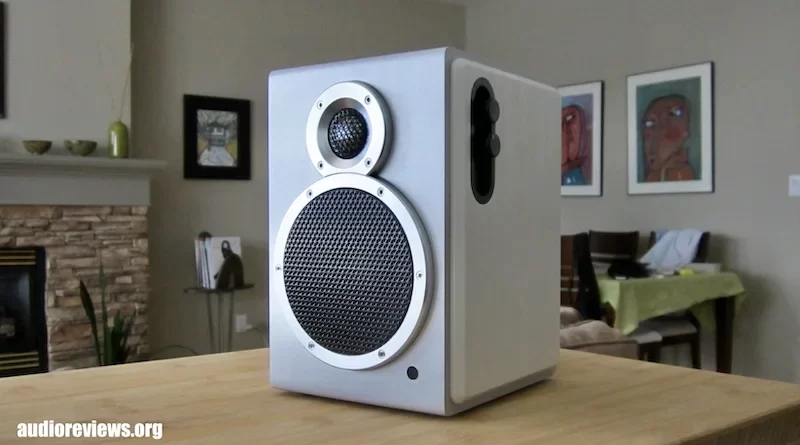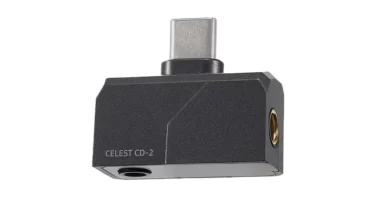FiiO SA1 High-Fidelity Desktop Active Speakers REVIEW – Sound On Sound
The $200 FiiO SA1 powered speakers were kindly provided by the company for my review – and I thank them for that. You can get them from the FiiO Audio Store.
The FiiO SA1 are powerful and good-sounding powered near-field speakers that offer Bluetooth 5.4 and a plethora of digital and analog inputs, and good tweaking ability.
PROS
- Healthy power and good sound quality
- Comprehensive digital and analog connectivity
- Bluetooth 5.4
- Very good haptic
- Phono stage
- Good value
CONS
- No Apple Airplay
- No fitting FiiO speaker stands available
In this Article
Introduction
I’m a headphone and earphone guy. And I have dabbled in digital music since 2003. For the last 20+ years I have been sitting in front of a Mac without the need for any near-field speakers. The internal loudspeakers had to do.
This has changed recently, when I replaced my last iMac with a Mac Mini M4 and a third-party display. The two newbies have a built-in speaker each (in theory) that sound like an old telephone. Desktop speakers were needed. After a short research, and upon the recommendation of my co-bloggers, I spent a whopping $40 on the Creative Pebbes V3. Everybody appears to have a pair.
When I plugged them in, I was instantly disappointed. Yep, they have good resolution and separation but less than zero bass, which makes them sound nasal and tinny above a certain volume level.
Great that FiiO asked me to analyze their new SA1 powered speakers, that is speakers with integrated DAC and amplifier. Spoiler alert: they really do it for me. Let’s first have a look at the specs:
Specifications FiiO SA1
| Model | SA1 |
| Product type | Desktop active speaker |
| Cabinet material | High-density MDF |
| Color | Twilight black/Cloud white |
| Dimensions | Main unit: About 135.5×155.6x185mm (including feet) Secondary unit: About 129×141.6x185mm (including feet) |
| Weight | Main unit: About 1750 g Secondary unit: About 1660 g |
| Bluetooth codec support | LDAC/AAC/SBC |
| Bluetooth version | 5.4 |
| Speaker crossover | Two-way active electronic, crossover point at 3.5kHz |
| Driver size | Woofer: 3.5 inches Tweeter: 3/4 inches |
| Diaphragm material | Woofer: Wood fiber cone Tweeter: Aluminum-magnesium alloy diaphragm |
| Frequency response | 65~20kHz |
| Amplification | 2 Texas Instruments TI TPA3118 Class D digital amplifiers |
| Power output | Woofer: 20W*2 Tweeter: 5W*2 |
| Bass adjustment | -6dB~0dB |
| Inputs | RCA/PHONO IN, AUX IN, USB IN, COAX IN, OPTICAL IN |
| Outputs | Subwoofer output (SUB OUT) |
| Signal input indicators | Sky blue: RCA, Pink: PHONO, Green: AUX, Purple: Optical Yellow: Coaxial, Orange: USB, Blue: Bluetooth |
| Bluetooth indicator | Lights flash red and blue when not connected in Bluetooth mode, light will stay blue after successful pairing and connection in Bluetooth mode. |
| USB/Optical/Coaxial support | USB: 96k/32bit Coaxial: 192k/24bit Optical: 96k/24bit |
| Product page | fiio.com |
| Tested at | $200 USD |
| Purchase link | Fiio Audio Store |
Physical Aspects
In the box are the two speakers with a connector cable between them, a cute remote (takes 2 AAA batteries), 18 V wall wart power adapter, a 3.5mm to 2x RCA cable, and a quick start guide.

Technology
The two-way SA1 is largely made of fiberboard (like North American house frames!!!) and features two Texas Instruments TI TPA3118 Class D digital amplifiers. The 3.5-inch woofer and the 3/4 inch aluminum-magnesium alloy dome tweeter offer a power of 20W and 5W each, respectively.
The speakers support a 31-band lossless PEQ (Parametric Equalizer) through the FiiO control app (free from App and Google Play Stores) and high-res LDAC Bluetooth codec (Bluetooth 5.4), but sadly not (the quasi lossless) Apple Airplay. The FiiO control app comes with 8 preset eq profiles, and you can add your own.

The right speaker is the control unit and is connected to the left secondary speaker by an included cable. The former offers two outputs (for the secondary unit and a subwoofer), and a comprehensive selection of inputs: analog RCAs and standard 3.5 mm Aux (when an external DAC is used), and coaxial and optical (utilizing the internal DAC). The RCA input can be switched to an internal phono preamp for connecting a record player such as FiiO’s TT13.
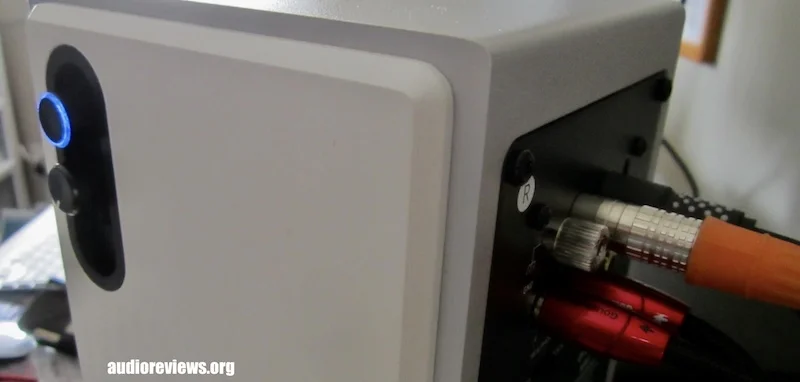
The right speaker (main unit) also features 3 knobs on its side, from top to bottom: a volume dial (with an RBG light indicator illuminated according to input (the medium blue in the above photo refers to RCA), a bass knob, and the on/off button.
The included remote covers most of the SA1’s functionality. If there is no incoming signal, the unit switches itself off after 20 mins.
Operation
Easy! You switch the unit on by the push of the upper button on the right speaker, then select your desired input. If you don’t like cables, you cannot connect from your handheld unit or computer via Bluetooth. If you prefer using your fancy desktop DAC, use the analog inputs. If you like wired and are happy with the SA1’s internals, the digital inputs will work for you.
Performance
I give you the opportunity to listen to the SA1. All you need is an earphone or headphone. The setup is as follows:
A Mac Mini M4 is used as music source and connected it to the FiiO K17 DAC-amp combo via a FiiO LT-TC5 USB-C cable. The K17 is connected both analog and digitally with the SA1, by an AudioQuest Golden Gate RCA cable, and by Blue Jeans coaxial and Belkin optical cables, respectively. This gives us the opportunity to compare the quality of the SA1’s internal DAC with the more expensive DAC in the K17.
Test the SA1 Yourself
It is your turn first. Yes, you can test the SA1, too. Here is a binaural recording of the speakers using Sennheiser electret microphones placed in my ears. If you use a headphone or earphone, you will hear the speakers as if you are sitting in front of them (but you have to consider quality loss through technical limits of microphones, lossy file, and your headphones/earphones).
The binaural (“two ears”) recording technology was developed in early 1970s Germany as “Kunstkopf Stereophonie”, designed for radio plays. It is a recording method to exactly reproduce the natural hearing process and enable maximally realistic recordings.
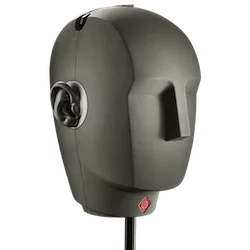
A dummy head (“Kunstkopf”) made of wood or plastic, with microphones placed in both ears, was used for recording scenes and sounds the same way as the human ear perceives them. The artificial head was a silent participant in the scene registering everything around it
When played back with (preferably open-back) headphones, the listener takes the position of the dummy head and moves into the centre of the acoustic action. He/she is totally immersed in sound. In contrast, in stereophonics (as we know it), the listener is in front of the scene.
Binaural recordings enable spatial hearing, they give the listener an accurate sense of distance and space, including up and down, and back and forth. Yes, one can hear sounds from behind of above one’s head. Picture a mosquito flying several times around you. Only possible with binaural.
The binaural soundstage can be infinitely large. A fantastic experiment of space, sound, and illusion. The effects suggest to the listener that they are in a different place, a different time and in a different environment…compare 3D virtual reality glasses.

Since binaural productions were rather expensive and headphones inconvenient for the masses at the time (compare to the more recent 3D TVs with glasses), the binaural technique went into hibernation after only a few years…in order to resurge with the rise of increasingly refined video games, Dolby Atmos, and surround sound as well as the widespread availability of headphones and lower recording costs.
The big questions are:
- How does the sound quality differ between these three inputs? What is gained from an external DAC?
- How good are bass delivery and transparency/clarity?
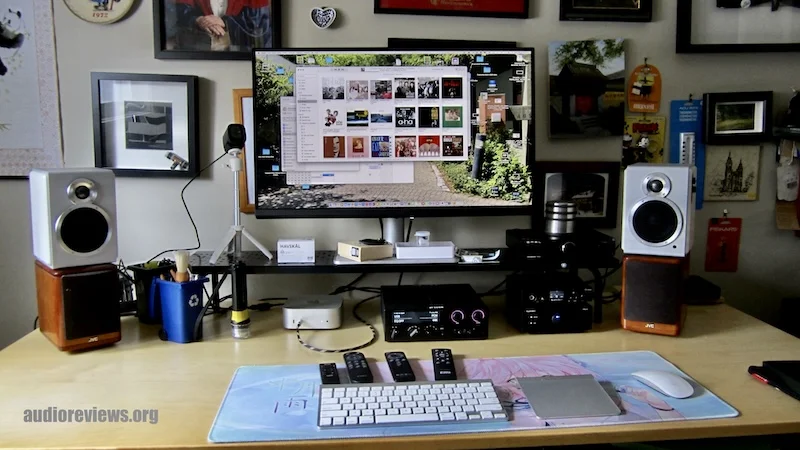
Feel free to report your impressions in the comments section below.
My own Impressions
When I first played music through the SA1, they sounded muddled. I quickly found the reason: the speakers were sitting with their rubber feet on my IKEA veneer desktop – way underneath my ears. I elevated the SA1 by putting them on some old JVC mini speakers. this brought out the best of the SA1.
I listened to all sorts of rock music, jazz, and classical. Generally, the SA1 showed a very satisfying bass response (down to 65 Hz). AC/DC produced a wall of sound, very tactile and right into my stomach. There is no need for a subwoofer at all (though there is connectivity for such). The SA1 offer imore than enough power, you cannot turn it up to 11 as it blows your eardrums out.
More sophisticated acoustic sets exhibited decent transparency and clarity with astonishing spacial reconstruction including a reasonably deep stage. I’d describe the sound as neutral without any harshness or shrillness, but also without any warmth added. Overall surprisingly mature! Very enjoyable!
When comparing the different connections, the K17’s DAC with the analog RCAs delivered the quietest sound, the digital coaxial with the SA1’s internal DAC the loudest, and the optical was somewhere in the middle. These volume differences were clearly audible but not dramatic.
When it comes to sound quality, the K17 DAC/RCAs produced the richest, most measured and composed sound, with the coaxial being a bit splashy and exuberant in comparison, and the ranking being in the middle again.
Bypassing the K17 and connecting the Mac Mini via Bluetooth 5.4 generated a leaner, quieter sound compared to the wired connections, particularly lacking the richness of the K17’s DAC with the RCA cables.
I can live well with any of these connectivities as my brain adjusted almost instantly to each of them. What this tells us is that the SA1 feature a decent DAC considering their $200 price tag.
Concluding Remarks
After some initial fiddling with the SA1, I am pleasantly surprised how good these little rascals are. They do perfect justice to my ears and I never had the impressions I needed better. In fact, listening to these kept me from testing headphones. The biggest issue is to find a fitting base or stand to bring the best out of these.
I boxed my brand new Creative Pebble V3 speakers up again and stored them in the basement. If you want them, you just have come by and ring my doorbell.
Until next time…keep on listening!

Disclaimer
Our generic standard disclaimer.



